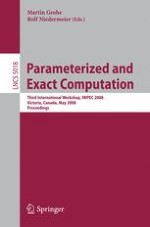This book constitutes the refereed proceedings of the Third International Workshop on Parameterized and Exact Computation, IWPEC 2008, held in Victoria, Canada, in May 2008 - co-located with the 40th ACM Symposium on Theory of Computing, STOC 2008. The 17 revised full papers presented together with 3 invited lectures were carefully reviewed and selected from 32 submissions. The topics addressed cover research in all aspects of parameterized and exact computation and complexity, including but not limited to new techniques for the design and analysis of parameterized and exact algorithms, parameterized complexity theory, relationship between parameterized complexity and traditional complexity classifications, applications of parameterized computation, implementation and experiments, high-performance computing and fixed-parameter tractability.









